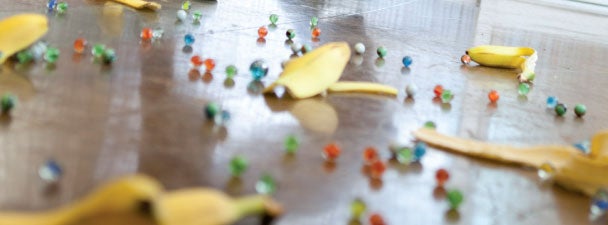
When it comes to slippery surfaces, we all need to get up to speed – at least that’s what Andrew Clark and his collaborator found in their research on slipping, sliding and stability.
“Counter to what some people think, faster speeds help us cross slippery surfaces without falling,” says Clark, assistant professor of biology, who – along with his colleague and former postdoctoral adviser at Clemson University, assistant professor of biology Timothy Higham (now at University of California–Riverside) – observed the locomotor biomechanics of helmeted guinea fowl navigating slippery surfaces at different speeds to investigate fall-avoiding strategies and the major causes of falls during these encounters. “The helmeted guinea fowl’s fall-avoidance strategies parallel human strategies because we’re both terrestrial, bipedal and endothermic (or warm blooded), and we both operate within the same laws of physics. So, helmeted guinea fowl serve as insightful crash-test dummies for us.”

The researchers put the birds on a six-meter runway lined with either sandpaper (a sticky, high-friction surface) or polypropylene shelving liner (a slippery, low-friction surface) and filmed their performance. What they found was that – although “some birds were clumsier than others” – the fowl did not fall if they ran faster than three meters per second. Any slower, and they’d risk hitting the ground at a limb angle of less than 70 degrees – a sure bet they’d fall backward.
“The most important factor for avoiding falls is your limb angle when you hit the ground. If you’re going too slowly, your center of mass (your hips) won’t shift forward enough when the foot makes contact with the ground at a small limb angle,” explains Clark, adding that when you’re moving quickly, your weight shifts forward more easily, resulting in the knee moving past the ankle and thereby stopping the slipping. “And that’s the other determining factor: threshold slip distance, or how far you have to slip before you fall.”
That distance, the researchers found, is 10 centimeters. And not just in fowl, but in humans, too.
“We knew that studying the biomechanics of locomotion in helmeted guinea fowl had definite health and human safety implications – and they could be especially important for elderly individuals, who have the increased likelihood of falling when moving on slippery ground,” says Clark, noting that once the research was published in the March 24, 2011 issue of the Journal of Experimental Biology, the mainstream media grabbed hold of the news, and articles were published everywhere from USA Today to the U.K.’s The Telegraph.
And, with applications anywhere there is a slippery surface, there’s no telling how far their research will go.
“This is just scratching the surface,” says Clark, explaining that there are lots of data still waiting to be analyzed. “We don’t have the full picture yet – but I’m certain that these kinds of data sets could address significant evolutionary and ecological questions. I can’t wait to see where it takes us next.”
After all, it’s hard to let this kind of momentum slip away.




